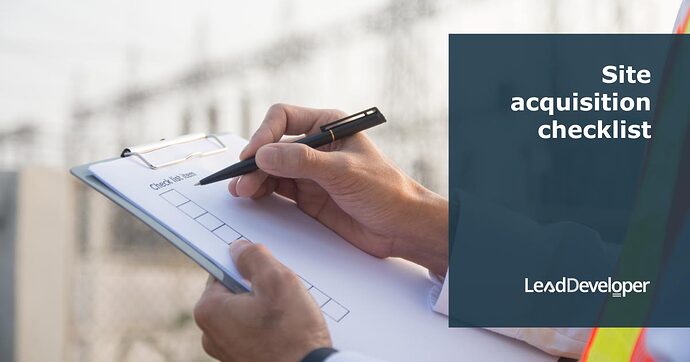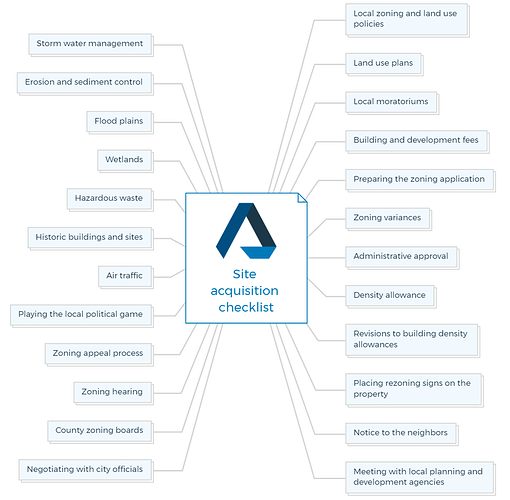Site acquisition checklist
1. Local zoning and land use policies
Understand the specific zoning regulations and land use policies that apply to the area where you’re considering site acquisition. These policies dictate how the land can be used, what types of structures can be built, and any restrictions that might be in place.
2. Land use plans
Review existing land use plans for the region. These plans provide a broader perspective on how the area is intended to be developed over time, ensuring that your acquisition aligns with the community’s long-term vision.
You are missing out if you haven’t yet subscribed to our YouTube channel.
3. Local moratoriums
Be aware of any temporary bans or moratoriums on development that might affect the area. These pauses in development could impact your timeline and plans.
4. Building and development fees
Factor in the costs associated with building and development fees when evaluating the financial feasibility of the site acquisition. These fees contribute to the infrastructure and services needed to support new development.
5. Preparing the zoning application
Properly prepare and submit the zoning application to initiate the process of seeking approval for your project. This involves providing all necessary documentation and information required by the local authorities.
6. Zoning variances
Determine whether any zoning variances are needed due to deviations from the standard regulations. Variances allow for flexibility in certain requirements but often require special approval.
7. Administrative approval
Some projects may qualify for administrative approval, which is simpler and quicker than going through public hearings.
Evaluate whether your project meets the criteria for such approval.
8. Density allowance
Understand the permitted density of development on the site. This refers to the maximum number of units or square footage that can be built on the property.
9. Revisions to building density allowances
If the proposed project exceeds the allowed density, consider requesting revisions to the density allowances. This might involve demonstrating how the project’s benefits outweigh the increased density.
10. Placing rezoning signs on the property
Place visible signs on the property indicating that rezoning is being considered. This informs neighbours and the community about potential changes and allows for input.
11. Notice to the neighbors
Provide official notice to neighbouring property owners about the proposed changes. This transparency fosters open communication and addresses any concerns they might have.
12. Meeting with local planning and development agencies
Attend meetings with local planning and development agencies to discuss your project. These interactions allow you to gather feedback, address concerns, and ensure your project aligns with local goals.
13. Negotiating with city officials
Engage in negotiations with city officials to gain support for your project. This could involve demonstrating the benefits your project brings to the community.
14. County zoning boards
Understand the role of county zoning boards in reviewing and approving zoning changes. Be prepared to present your case to these boards if required.
15. Zoning hearing
If a zoning hearing is necessary, prepare to present your case to local authorities and potentially address concerns from the public.
16. Zoning appeal process
Familiarize yourself with the process for appealing zoning decisions if your application is initially denied. This process allows for a review of the decision by higher authorities.
17. Playing the local political game
Recognize that local politics can play a role in the approval process. Building relationships and understanding the local political dynamics can influence the outcome of your project.
18. Air traffic
Evaluate the potential impact of air traffic on your site. This is particularly relevant if the site is located near airports or flight paths.
19. Historic buildings and sites
Consider any historic buildings or sites on or near the property. These may have preservation restrictions that could impact your plans.
20. Hazardous waste
Assess the presence of hazardous waste on the site. Addressing these issues is critical to ensure safety and compliance with environmental regulations.
21. Wetlands
Identify wetlands on or near the property. These protected areas have specific regulations that must be adhered to during development.
22. Flood plains
Determine whether the property is located in a flood plain. If it is, you’ll need to consider flood mitigation measures in your design.
23. Erosion and sediment control
Plan for erosion and sediment control measures to prevent soil erosion and protect nearby water bodies during construction.
24. Storm water management
Address stormwater management requirements to prevent flooding and manage runoff effectively. This might involve creating retention ponds or using other techniques.
This checklist ensures that you’re well-prepared to make informed decisions and navigate the complex landscape of regulations, environmental concerns, and community engagement throughout the site acquisition process.


